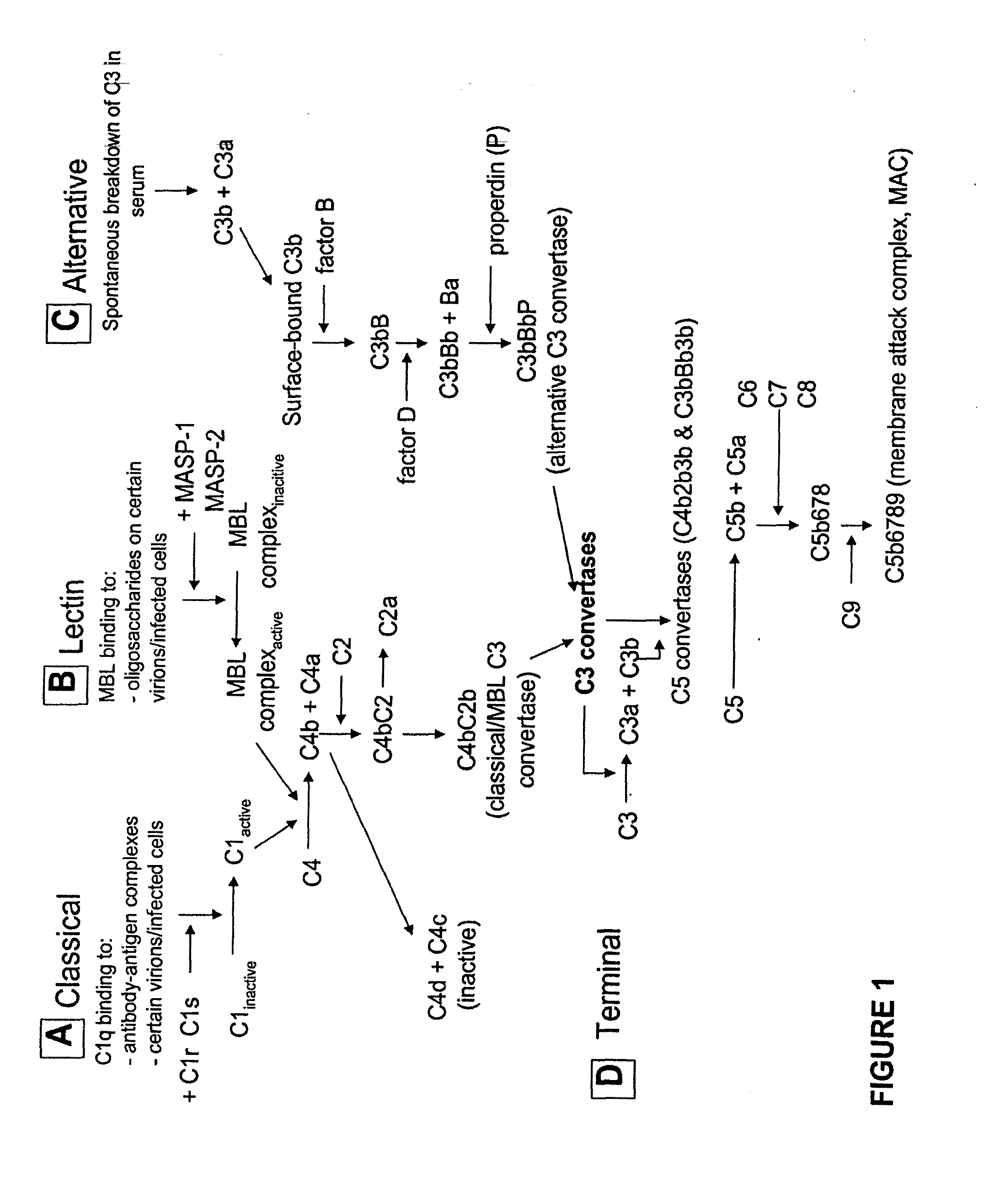Modified proteases that inhibit complement activation
a technology of complement activation and modified proteases, which is applied in the field of compounds for modulating the complement system, can solve the problems of limiting the strategy for preparing such therapeutics and their role, and achieve the effects of reducing or altering activity, increasing selectivity or substrate specificity for a target substra
- Summary
- Abstract
- Description
- Claims
- Application Information
AI Technical Summary
Benefits of technology
Problems solved by technology
Method used
Image
Examples
example 1
Cloning and Mutagenesis of MT-SP1
[0554]Wildtype MT-SP1 was cloned into the pQE32 bacterial expression vector (Qiagen, SEQ ID NO:345) C-terminal to the 6 histidine tag using the BamH1 and HindIII restriction sites. The construct included pro-region, activation sequence, and protease domain, and contained residues 598 to the C-terminus of the sequence published by Takeuchi et al. (1999) PNAS 96:11054 and SEQ ID NO:2 (i.e. corresponding to residues 598 to 855 of the sequence of amino acids set forth in SEQ ID NO:2). Mutants were generated by the Quikchange site directed mutagenesis (Stratagene). Briefly, a PCR sample reaction was set up containing the wildtype MT-SP1 as a template and oligonucleotide primers designed to contain the desired mutation (see Table 21). The PCR reaction was as follows in a 50 μl total reaction volume: 5 μl 10× Reaction Buffer, 1 μl MT-SP1 DNA template (100 ng / μl), 0.5 μl 50 μM forward Primer, 0.5 μl 50 μM reverse Primer, 1.0 μl dNTPs, 41.0 μl H2O, and 1.0 μl...
example 2
Expression and Purification of MT-SP1
[0556]Wild-type and modified MT-SP1 were cloned into the pQE32 bacterial expression vector (Qiagen, SEQ ID NO:345) containing an N-terminal 6 histidine tag, prodomain, and protease domain as discussed in Example 1 above and the resulting constructs transformed into BL-21 E. coli cells. Cells were grown in 100 mL cultures to an OD of 0.6, and expression of the protease in inclusion bodies was induced by adding IPTG to a final concentration of 1 mM. After 4-6 hours, the bacteria were pelleted by centrifugation and the pellet resuspended in 50 mM Tris pH 8, 500 mM KCl, and 10% glycerol (buffer A). Cells were lysed by sonication and pelleted by centrifugation at 6000×g. Pellets were resuspended in 50 mM Tris pH 8, 6 M urea, 100 mM NaCl and 1% 2-mercaptoethanol (buffer B). Membrane and organelles were pelleted by centrifugation at 10,000×g and the supernatant was passed over a nickel NTA column (Qiagen). The column was washed with 50 mM Tris pH 8, 6 M...
example 3
Expression and Purification of Modified MT-SP1 CB155 in Shake Flasks
[0557]CB155 and related recombinant human serine protease mutants as well as the wild-type MT-SP1 protease were cloned and expressed in E. coli as inclusion bodies as described in Examples 1 and 2 above. The production of the MT-SP1 or mutants was adapted for laboratory scale by pooling up to 30×1 L shake flasks for subsequent isolation of the inclusion body pellets for solubilization and refolding. Briefly, the MT-SP1 mutant CB155 plasmid construct was transformed into XL-1 Blue Supercompetent cells and a single fresh colony was picked and grown in 25 ml of luria broth (LB; Difco LB Broth Lennox, approximate formulation per liter: 10.0 g Tryptone, 10.0 g Yeast Extract, 5.0 g Sodium Chloride) containing 50 μg / ml carbenecillin at 37° C. overnight. Ten milliliters of the overnight culture was diluted into 1 L of LB in an Ultra Yield Flask (2.5 L) and was shaken at 37° C. to an OD600 of about 0.6 to about 0.7 (i.e. sha...
PUM
| Property | Measurement | Unit |
|---|---|---|
| Fraction | aaaaa | aaaaa |
Abstract
Description
Claims
Application Information
 Login to View More
Login to View More - R&D
- Intellectual Property
- Life Sciences
- Materials
- Tech Scout
- Unparalleled Data Quality
- Higher Quality Content
- 60% Fewer Hallucinations
Browse by: Latest US Patents, China's latest patents, Technical Efficacy Thesaurus, Application Domain, Technology Topic, Popular Technical Reports.
© 2025 PatSnap. All rights reserved.Legal|Privacy policy|Modern Slavery Act Transparency Statement|Sitemap|About US| Contact US: help@patsnap.com

